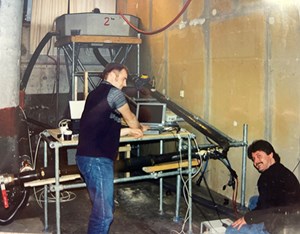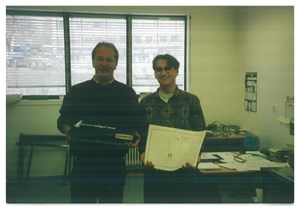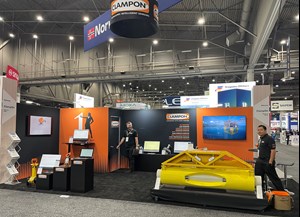ClampOn celebrates 30 years of innovation
(WO) — Founded in 1994 with very few resources, the growth and evolution of Norwegian firm ClampOn is not only a great success story, it also serves as a classic textbook example of oil and gas entrepreneurship.
As of 2024, ClampOn has been in operation for 30 years. Accordingly, the time is certainly ripe to share more about our company’s history and how it has evolved over the years.
What prompted us (Geir Instanes and Dag A. Aldal) to start in the first place? What dreams did we have, and what foundation did we have in the beginning? What drove us? How do you develop technology when you don’t have money? How did we build up the company, and most importantly, where did we learn about all this? And how have we managed to maintain our independence throughout these years? What about the various crises that affect businesses — and how have times changed during this 30-year period?
Our original concept. We clearly understood we were diving into one of the toughest and most competitive international industries — oil and gas — when we started. Our goal was to establish a company in ultrasonic instrumentation that could compete in the industry. Now, 30 years later, we can actually say to ourselves that we achieved it alongside all our great colleagues, who joined us on this journey.
We already had a strong background with ultrasonic technology, and we were determined to become “Always Numero Uno” in what we called “Ultrasonic Intelligent Sensors” — this became our vision! Saying it is one thing; making it happen is a whole different ball game.
Let it be said: Well-adjusted and harmonious people don’t become entrepreneurs. Entrepreneurs are frustrated individuals, who want to create change, to make something happen! And there we were, two frustrated entrepreneurs with plenty of plans and boundless energy.
Getting started. We lacked almost everything at the start: finances, technology, and a network there was nothing at all. Our only assets were our dreams and our working capital, and that is actually the best capital in the world.
We borrowed a closed classroom, I sold a car, and Geir delivered newspapers in the morning. That’s how we got started. The only thing we had plenty of was hunger for success. We wrote down our dreams about business philosophy and technology, and then we began developing our first ClampOn ultrasonic sensor for monitoring sand particles — this was in the fall of 1994!
Our premises were of such a poor quality that they did not invite visitors at all, but that was fine, because it was crucial for us to focus and complete the development of our first sensor. We had extremely limited equipment; the little money we had was used to acquire an oscilloscope. Otherwise, we borrowed equipment from friends and acquaintances.
The disadvantage of being financially tight has its advantages — not having an abundance of money is a brutal but excellent teacher. It teaches you to stay focused, not to waste time or money. Creativity, problem-solving, hard work, and cost-consciousness are the keywords.
Readying the prototype and finances. We worked day and night, and as 1994 ended and 1995 began, the prototype was ready — all tests showed that we were onto something good. We then had to obtain an ex-certificate to use the instrument on an oil installation, which took us six more months at the modest price of $4,500. By comparison, today’s price is around $50,000 to $70,000!
We secured financing through loans — a total of $35,000, a fortune for us at the time. What was the security? Our homes! We were absolutely certain that we would succeed. The blind and almost unfounded belief carries tremendous power.
Our first test placement. In the fall of 1995, we were ready with our first ultrasonic meter for the market. Now, we needed a test installation; we had to acquire references. The hunt began, and we contacted both familiar and unfamiliar parties to test the instrument in the field.
bp’s Gyda platform in the North Sea said yes (thank you), and we set out with the instrument and courage. And it went well — very well! The test lasted for about one week; we had a hiccup in the software, and Geir had to get up every fourth hour to restart it. We then knew that we had developed a compact and efficient instrument that we were confident would outperform all others in the market. It may sound arrogant, but one must carry a dose of self-assurance as capital when venturing into the world— and we had now proven that theory and practice matched.
The next challenge: We needed to secure paid contracts! This turned out to be more difficult than we had anticipated. The largest operator in the Norwegian sector of the North Sea wouldn’t let us in; we simply were not allowed to submit a bid. Well, then it was time to jump on the next flight and approach every possible customer internationally to showcase our advantages. We defined the oil industry as our domestic market — also as a trick to boost our own confidence. And it worked!
The phone rang; it was Total UK on the line, eager to lease an ultrasonic sand monitor for one of their high-velocity wells. We sent the quotation, and the contract was signed and returned. The equipment was packed and prepared for shipment. The phone rang again — the engineer from Total was now quite focused on finding out about references for the instrument. Then came the question: “Does it actually work?” My shoulders relaxed. “YES,” I confirmed firmly. The instrument was sent, and the assignment was completed successfully. The invoice was sent and paid, with every penny counted in those times.
Then followed a request from Texaco at Erskine field; they needed ultrasonic sand monitors for one of their new fields in the UK sector. We won this! It wasn’t just our first regular sale of ultrasonic meters; it was also our first export. Let it be noted that there are risk-takers in oil and engineering companies. Engineers who take chances, because they want to adopt new technologies. And still today, the industry needs those risk-takers.
The next opportunity came in the Norwegian sector with Saga Petroleum. In the spring of 1996, we sold four monitors that we installed at Snorre field.
Building on the momentum. All these sales were of enormous significance for us. They provided much-needed funds, references, and confirmations that we were on the right track. We began building a company, hiring some employees, and acquiring systems. At that time, we were an extremely small organization, where everyone did absolutely everything — from cleaning floors to acting as each other’s taxi. Everyone was a service engineer, a project engineer, and, above all, a salesperson, Fig 1. We shaped each other and learned from everything that happened along the way — laying the foundation for ClampOn’s future.
During this period, we discovered our core values and developed our attitudes. Every one of us pulled together every day; we became a family that, to this day, stands together through thick and thin. This core spirit remains with ClampOn today, constantly seeking improvements and conquering new territory. We are an organization that cares for one another, supports each other, and lends a helping hand whenever needed. This unity has tremendous power in overcoming the challenges that arise. No one on this team is greater than ClampOn! It’s a resilient and creative organization, always ready for action. ClampOn embodies sustainability in practice.
It was almost profoundly quiet for us in the Norwegian sector until 1999. It takes time to gain recognition among one’s own people. We didn’t give in to depression because of that. On the contrary, we found it motivating. We were on the move around the clock and around the world to secure new contracts, showcase ourselves, and spread the good message/knowledge to anyone willing to listen.
Becoming an international company. We traveled all over the world to communicate our technology’s advantages — every continent was explored. Anyone with needs, budgets and influence was at risk of being approached by ClampOn. We were on the path to becoming an international company. We went to exhibitions, conferences, and meeting rooms with energy and conviction. We were determined to succeed!
We made plans to establish an office in Houston during the fall of 1996. We scoured the Gulf of Mexico market, and we were confident. We had to enter this market. It would be absolutely crucial for us. At that time, we had only seven employees at the Bergen office, so we didn’t have many colleagues to choose from when it came to staffing an office in Houston. While planning this, I received the following question from a top executive in the Norwegian oil industry, who had heard about our Houston plans — “Dag, do you actually know what you’re doing?”
The question was certainly appropriate, and I answered completely honestly: “No, we don’t. That’s precisely what we’re going to find out!”
Because that’s the whole point of an entrepreneur’s journey: You don’t really know what will happen; you have to set out on the journey to discover it. We have dreams and ideas, and when we bring those dreams to life, we find out what we’re truly doing. In the spring of 1997, we were on our way to Houston, to set up offices at Innovation Norway. A more modest and down-to-earth start in the world’s largest market would be hard to find — just one employee! We were underway; it was time to print business cards and position ourselves with customers and engineering companies, Fig. 2.
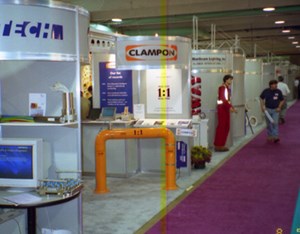
Expanding the product line. At the same time, we introduced our next sensor: a ClampOn topside compact sand monitor, considerably smaller in size, with digital processing, Fig. 3. We could now bid farewell to our competitors with our technical advantages.
Shell Brent now expressed their interest in our products. Engineers liked the technology and conducted comparative tests with competing equipment. There was no doubt at Shell; we won all the tests and ended up with a delivery of 120 sensors for all the Brent platforms in the UK North Sea sector. Gradually, we were on solid financial ground, and we now had the means to invest further in building ClampOn. The monitoring systems installed on Shell Brent were initially intended as backup solutions. However, it didn’t take long before they were utilized as first-line systems to ensure maximum production under safe conditions.
This development coincided nicely with our establishment in Houston, when Shell in the Gulf of Mexico (GOM) had clear offshore development plans. These were subsea fields that required monitoring, and Shell wanted our technology on the seabed. We lacked subsea expertise, and Shell connected us with FMC to design a system that could function for 25 years or more on the seabed. Once again, this highlights the importance of having entrepreneurs within oil companies, who push for new solutions.
By 1998, we were signing a contract with Shell for the development of ClampOn’s Deepwater Particle Monitor. The development was completed in the fall of 1999, and we began delivering our first subsea meters to Shell Deepwater in the GOM. Concurrently, we received orders from other companies. Finally, we started receiving enquiries from the Norwegian sector as well; we began securing contracts in Norway, too.
The challenges of breaking through in our own home market were perhaps the best “help” we could get. Instead, we focused on building an international network — a valuable network that brought us contracts, Fig. 4. To this day, ClampOn’s exports account for 90% of our business, and it has been this way for almost 30 years!
Over time, ClampOn delivered measurement systems to the entire industry worldwide. Around the turn of the millennium, our organization had no more than 17 employees in an industry that involved extensive travel. Installations, conferences and meetings with customers to discuss solutions were part of our routine.
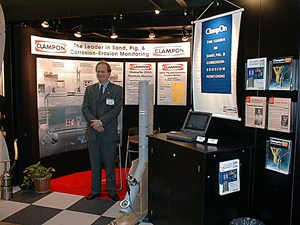
Innovative technology. For all these years, we have constantly focused on technology development, work primarily led by Vice President Geir Instanes. Much of this development has been self-financed, and there are several good reasons for that. We can set our own pace, allocate resources as needed, and it’s easier to protect our trade secrets. However, there are times when it’s essential to collaborate with oil companies and larger players, especially when costly tests need to be conducted or subsea installations belong to others.
Our technological advancements have fortified our foundation as a company. From being a “one-product company,” we are now a complete provider of topside and subsea systems, covering leak detection, pig detection, vibration monitoring, sand monitoring, and, crucially, corrosion-erosion monitoring, Fig. 5.
Over the years, we’ve practically flooded the market with technological ultrasonic solutions, both topside and subsea. In addition to sand and corrosion systems, we’ve developed sensors for vibration, leak detection, temperature, and various condition monitoring applications."
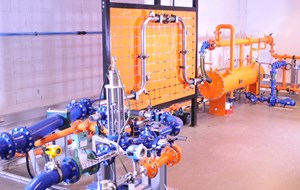
Corrosion measurement is one of the most challenging developments we have ever embarked upon. It wasn’t until the third version of the instrument that we had something that could truly meet both our own and our customers’ expectations for what the market needs in this field.
It must be said that making mistakes is sometimes an essential part of the process of arriving at a good product. It’s painful along the way, but in the process of identifying the causes of errors, we also find the answers to future solutions.
Once we had overcome all the barriers in developing the topside solution, the path was clear to venture into the subsea market. Our subsea corrosion-erosion system has been in the market for approximately 14 years. It has been a continuous process of improvement, allowing us to steadily gain larger market shares and establish ourselves as leaders in this critical field.
Operating philosophy. There are many reasons why we have succeeded over the years, and it’s tempting to say that it’s the sum of all factors that has brought us to where we are today, Fig. 6. We have invested significant effort in creating a compact and knowledgeable team to harness the opportunities presented by our technology. The work environment and relationships among those of us who collaborate daily are crucial to the company’s development. We value openness and discussions to arrive at the best solutions, and once those solutions are found, we move forward at full speed — discussions are concluded, and implementation begins.
ClampOn has always been faithful to the idea of having “everything in one place” — meaning development, production, projects, sales and service. And the place we are anchored to is Bergen, the pearl of the Norwegian west coast. We believe in thoroughly understanding our products, and how they perform throughout the entire manufacturing process. It doesn’t take long to gather the necessary knowledge to solve any problems that arise. This has served both our customers and ourselves well — we thrive on selling quality instruments that work exceptionally. When we say “Always Numero Uno,” it’s a promise to ourselves and the market. We aim to be number one in what we do, and if not, we either need to find a solution or quit.
We value long-term relationships, whether with subcontractors, customers, partners or employees. Every day, we build the company and its values. As an independent company for 30 years, has this benefited ClampOn? Absolutely! Good ownership is only possible when you have knowledge of the market and the company you manage.
Knowledge isn’t solely about money. ClampOn’s founders and main shareholders have taken an extremely long-term approach to the company and the people who work there. This commitment wouldn’t have been possible, if the company were owned by financial investors. ClampOn’s owners have found joy in developing technology, the company, and the market alongside skilled employees, and that’s how we’ve succeeded in the industry.
ClampOn has some peculiarities that, for us in our daily work, are entirely normal. In the company’s board, we find the company’s founders alongside management and employees. This requires respect for each other’s roles when we gather in the boardroom to discuss ClampOn’s further development. Among the company’s ten leaders, four are women. While we started in a classroom where we couldn’t receive visitors, today we have state-of-the-art facilities, where heating and energy are sourced from nine geothermal wells in addition to solar panels. From being a handful of employees at the turn of the millennium, we now have 120 employees. In fact, ClampOn has become the world’s largest supplier of ultrasonic measurement systems to its industry!
Looking to the future. And we still dream new dreams every day, some of which translate into new products for new markets. Our future is increasingly moving toward wireless and battery-powered solutions, along with AI technology. The world demands sensors with maximum intelligence, and that’s where ClampOn is, and will continues to be.
Would we do it all over again? Absolutely!
Would we establish ourselves in Norway and Bergen once more? No, the country’s politicians have become so distant from the industry, business, and ordinary people that we’re not sure it would be logical to establish ourselves in Norway again. The country’s economic policy in recent years has become unpredictable and lacks sustainability.
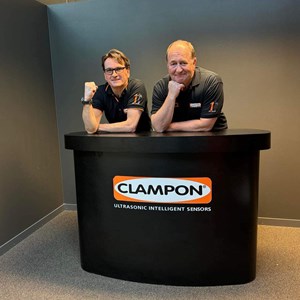
Is there anything we would avoid doing if we could choose again? Yes, but the most important thing is that we learn from our mistakes — and that learning actually depends on making mistakes!
Where does ClampOn go from here? New technologies are emerging, and we’re committed to staying at the forefront. We are venturing into new markets, establishing offices in strategic locations and building relationships with clients worldwide. We will remain true to our values and uphold our visions: Always Numero Uno! (Fig. 7) and Ultrasonic Intelligent Sensors.
It’s time to thank everyone who has been with us on this journey: customers, suppliers, partners, all of you who cheered for us and especially our loyal hardworking employees! We are getting ready for the next 30 years!
ClampOn Topside Corrosion-Erosion Monitor
ClampOn Subsea Corrosion-Erosion Monitor

